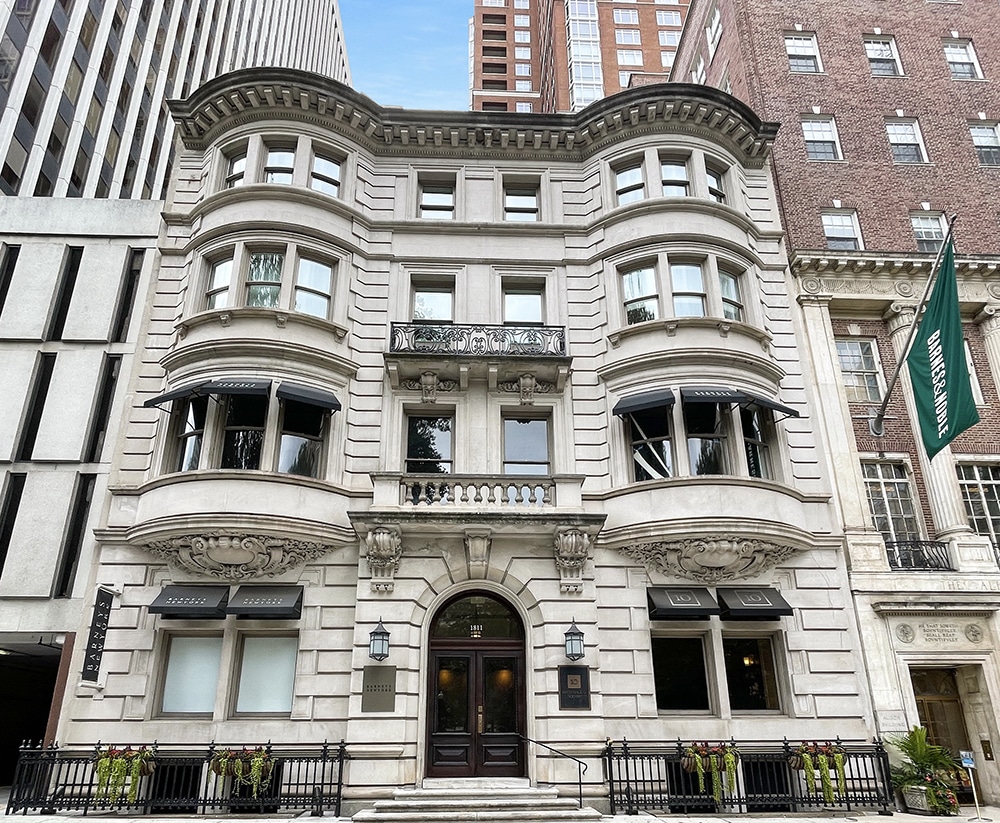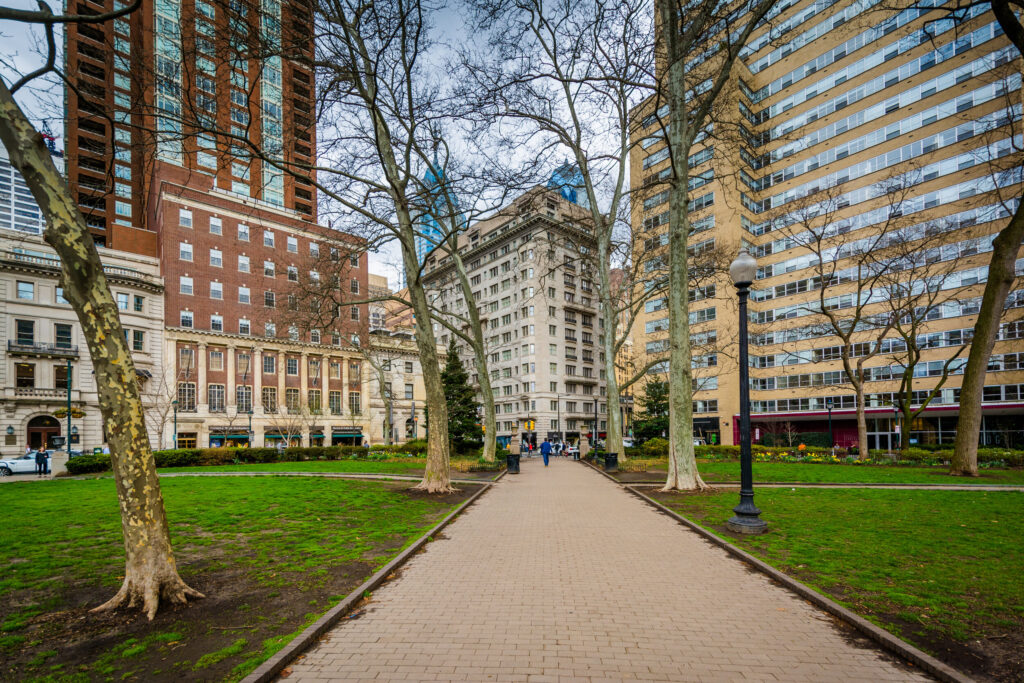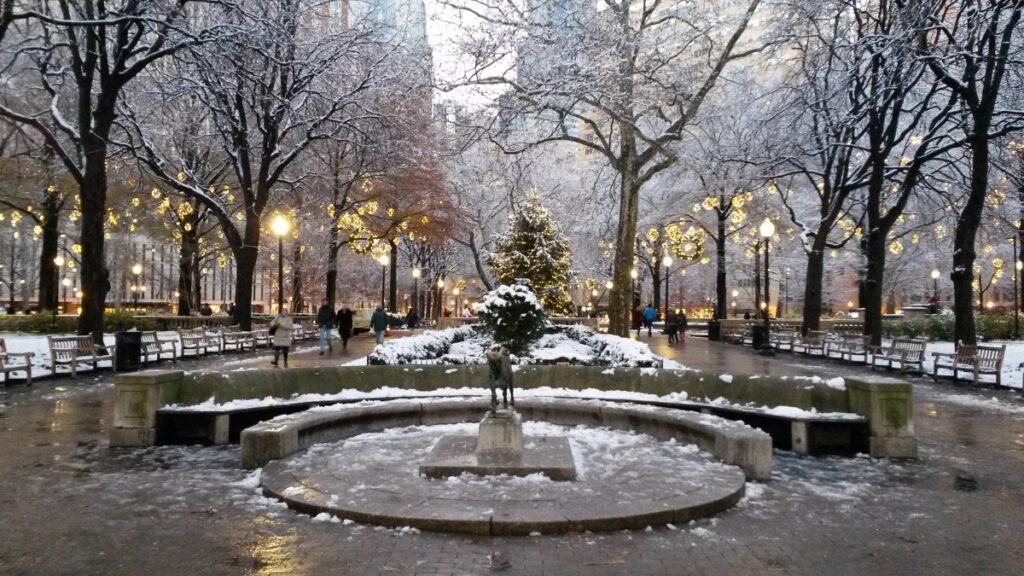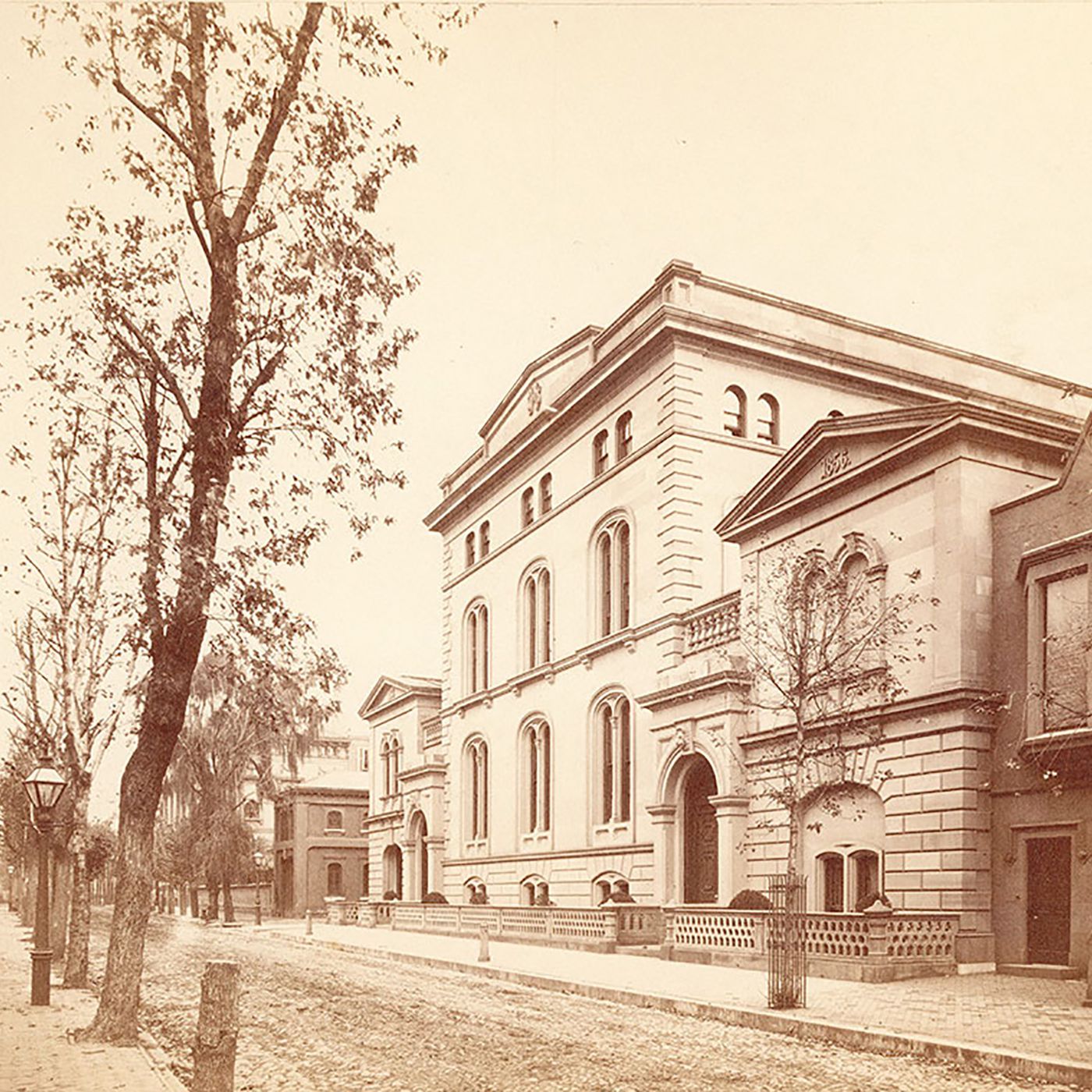Rittenhouse Square in Philadelphia
Rittenhouse Square, a gem in the heart of Center City, Philadelphia, stands as one of the five original squares planned by William Penn in the late 17th century. This neighborhood is not just a testament to historical design but has evolved into an area known for its elegant townhomes, high-rise luxury apartments, and a vibrant blend of local businesses, stylish boutiques, and trendy restaurants. Its allure attracts not only Philadelphians but out-of-towners seeking the quintessence of city living.
As a cultural and social hub in Philadelphia, Rittenhouse Square offers more than just aesthetic delight. From the lush green space of the park itself, hailed as an urban oasis, to the surrounding high-end stores, locally owned boutiques, and diverse dining options, this neighborhood promises a comprehensive guide to enjoying city life. Whether it’s exploring cultural landmarks, indulging in fine dining, or enjoying leisurely shopping, Rittenhouse Square encapsulates the spirit of Philadelphia’s urban sophistication.
The Historical Significance of Rittenhouse

Rittenhouse Square’s journey from a planned green space to a bustling neighborhood is a testament to Philadelphia’s growth and the square’s adaptability. Initially envisioned by William Penn in the late 17th century as one of five open-space parks, its evolution reflects the city’s changing needs and tastes.
- 1682: William Penn founded Philadelphia, introducing Rittenhouse Square as Southwest Square.
- 1825: Renamed in honor of David Rittenhouse, a prominent astronomer and inventor, acknowledging his contributions to the city and the nation.
- 1840s-1850s: The area around the square began to develop into Philadelphia’s most fashionable residential section, attracting the city’s burgeoning ‘Victorian aristocracy’.
The transformation of Rittenhouse Square over the centuries showcases its significance beyond just a public park. It became a symbol of luxury and high society in Philadelphia, with mansions and upscale residences lining its perimeter. This shift not only marked the square as a desirable address but also as a cultural and social gathering spot. The introduction of apartments and condominiums in the 20th century further diversified its residential appeal, making it a vibrant community hub in modern-day Philadelphia.
Cultural Landmarks and Attractions
Rittenhouse Square is not only a lush urban retreat but a cultural epicenter in Philadelphia, surrounded by an array of boutiques, restaurants, art galleries, and cultural institutions that cater to both locals and tourists. The neighborhood is home to several landmarks that enrich the city’s cultural landscape:
- Cultural Institutions & Museums:
- The Mütter Museum, known for its intriguing collection of medical exhibits.
- The Rosenbach offers rare insights into literary and art history.
- Curtis Institute of Music, fostering world-class musical talent.
- The Philadelphia Art Alliance, Civil War and Underground Railroad Museum, and the Philadelphia Youth Orchestra add to the neighborhood’s cultural diversity.
- Art & Performance Venues:
- Kimmel Center for the Performing Arts hosts a variety of performances year-round.
- Nearby, the Parc Restaurant and The Franklin Mortgage and Investment Company offer dining experiences that blend culinary arts with cultural ambiance.
- Outdoor Sculptures & Events:
- Rittenhouse Square Park showcases sculptures like Lion Crushing a Serpent and Duck Girl, adding an artistic touch to the green space.
- Annual events such as the Rittenhouse Square Spring Festival and Fine Art Show bring the community together in celebration of arts and culture.
These cultural landmarks and attractions underscore Rittenhouse Square’s role as a vibrant hub for arts, learning, and community gatherings, making it a must-visit destination in Philadelphia.
Rittenhouse Square Park: An Urban Oasis
Nestled in the heart of Philadelphia, Rittenhouse Square Park serves as an urban oasis for a diverse array of visitors. From sunbathers soaking in the warmth to avid readers lost in their books, the park is a vibrant hub of activity. Families, artists, and dog owners find solace and inspiration in this green space, which is also the venue for numerous community events including festivals, farmers’ markets, and fairs. The park’s allure is magnified by its accessibility, open daily from 9:00 AM to midnight, ensuring that everyone has the opportunity to partake in its offerings.
- Amenities and Features:
- Dedicated dog area for pets to socialize
- Lush greenery and meticulously maintained flower beds by the Rittenhouse Square Flower Market
- Family-friendly features such as diagonal walkways, a plaza with a reflecting pool, and classical urns
Rittenhouse Square Park is not just another city park; it’s a pivotal gathering place that fosters community spirit and urban tranquility. With its strategic location at 18th and Walnut Streets and a maintenance team led by The Friends of Rittenhouse Square, the park’s beauty and vibrancy are preserved year-round. Whether it’s for a leisurely picnic, a stroll among the trees and sculptures, or to enjoy the myriad of organized events, Rittenhouse Square Park embodies the spirit of Philadelphia’s community life and urban sophistication.

Dining and Entertainment
Rittenhouse Square in Philadelphia is not only a symbol of architectural beauty and urban sophistication but also a culinary paradise that caters to the tastes of food enthusiasts and social butterflies alike. The neighborhood’s dining scene is as diverse as it is innovative, with establishments ranging from high-end restaurants to cozy, independent coffee shops, making it a prime destination for both locals and tourists.
- Fine Dining and Specialty Cuisines:
- Parc Brasserie: Offers an all-day French dining experience with a view of Rittenhouse Square.
- Vernick Food & Drink: Known for its seasonal American cuisine, it’s a go-to for special occasions.
- Barclay Prime: A high-end steakhouse perfect for impressing clients or dates.
- Lacroix Restaurant at The Rittenhouse: Specializes in French cuisine with dishes like American wagyu and bordelaise.
- Casual Eats and Social Spots:
- The Love: Ideal for brunch or dinner with parents, known for its American cuisine.
- Mission Taqueria: A vibrant Mexican restaurant famous for its margaritas.
- Harp & Crown: An enormous space perfect for large groups, offering cocktails and pizza.
Whether seeking a luxurious dining experience, a casual meal, or a lively social scene, Rittenhouse Square’s establishments provide an array of options to satisfy any palate. The neighborhood’s emphasis on safety, prestige, and a central location further enhances its appeal as a dining and entertainment hub.
Shopping in Rittenhouse
Shopping in Rittenhouse Square is a delightful experience, blending the charm of local boutiques with the sophistication of national retailers. This area, particularly known as Rittenhouse Row, is a premier retail district in Center City Philadelphia, offering shoppers a diverse mix of shopping destinations.
- National Retailers and Flagship Stores:
- Nordstrom Rack, Uniqlo: For fashion-forward finds at a discount.
- Anthropologie, Free People, Urban Outfitters: Unique urban style in flagship locations.
- Vince, rag & bone: High-end fashion for the discerning shopper.
- Local Boutiques and Specialty Shops:
- Joan Shepp, Boyds: Landmark destinations for designer wear.
- Omoi Zakka: Unique gifts and jewelry for those seeking something different.
- DiBruno Brothers: A gourmet marketplace offering an extensive selection of cheeses, meats, and more.
- Breakaway Bikes & Training Center: For cycling enthusiasts looking for quality gear and coaching.
The Shops at The Bellevue and The Shops at Liberty Place further enhance the shopping experience in Rittenhouse Square, offering a range of upscale and stylish shops, from Nicole Miller and Polo Ralph Lauren to Williams Sonoma. Meanwhile, Walnut Street, between Broad and 18th Streets, remains a bustling shopping district, known as Rittenhouse Row, featuring high-end boutiques and trend-setting stores. Whether it’s upscale fashion, unique gifts, or gourmet food shopping, Rittenhouse Square caters to a variety of tastes and preferences, making it a must-visit destination for anyone looking to indulge in a bit of retail therapy in Philadelphia.
Living in Rittenhouse
Living in Rittenhouse Square presents a blend of urban sophistication and historical charm, making it one of Philadelphia’s most sought-after neighborhoods. Situated at 18th and Walnut Streets, this affluent area boasts a variety of living options, from luxurious single-family homes to contemporary condominiums and apartments. Here’s a closer look at what it means to call Rittenhouse Square home:
- Housing Overview:
- Median Single-Family Home Value: $1,099,700
- Median Condominium Value: $445,800
- Median Apartment Rent: $1,743
- Notable Listings: For instance, a single-family home at 2123 Cypress St. priced at $1,186,000 and a Barclay condo at 237-47 S. 18th St., #13A for $2,700,000.
- Transportation and Accessibility:
- SEPTA Broad Street Line, Market-Frankford Line, Trolley Lines
- PATCO Lindenwold Line
- SEPTA Bus Routes
- Convenient access to Suburban Station and Amtrak’s 30th Street Station
- Community and Lifestyle:
- Described by real estate agent Mike McCann as one of the city’s most desirable areas
- Challenges include affordability and parking
- Hosts outdoor markets like the Rittenhouse Square Fine Art Show
- Maintained by the Friends of Rittenhouse Square, ensuring cleanliness and upkeep

Residents enjoy a park-like setting amid historic 19th-century mansions, high-end shopping, alfresco dining, and proximity to city sights. Despite its occasional noise and crowding, the neighborhood’s elegance and convenience continue to draw people seeking a vibrant urban lifestyle.
Throughout this exploration of Rittenhouse Square in Philadelphia, we’ve journeyed from its historic origins as one of William Penn’s five original squares to its current status as a vibrant hub of culture, cuisine, and community. Alongside uncovering the rich tapestry of historical development, the guide illuminated the myriad of experiences Rittenhouse Square offers—from cultural landmarks and lush parks to a diverse dining scene and exclusive shopping options. The essence of city living is encapsulated here, inviting both locals and tourists to immerse in the sophisticated charm that defines this neighborhood.
The significance of Rittenhouse Square extends beyond its boundaries, serving as a microcosm of urban evolution and a beacon of community spirit in Philadelphia. As we reflect on the neighborhood’s journey and the collective narrative of those who’ve contributed to its allure, it’s clear that Rittenhouse Square remains not just a destination, but a living history and a vibrant tableau of urban sophistication. It stands as an invitation to explore, engage, and cherish the essence of Philadelphia’s heart, promising unique experiences and cherished memories for all who wander its paths.
FAQs
What is the main attraction of Rittenhouse Square? Rittenhouse Square is renowned for its arts and culture scene. It is encircled by high-rise residences, upscale apartments, an office tower, and a selection of popular dining venues. Although the Barnes & Noble bookstore has closed, the area still features a Starbucks known for a racial discrimination incident and a five-star hotel.
How safe is it to explore Rittenhouse Square on foot? The Rittenhouse Square neighborhood is considered extremely safe. Many apartment buildings in the area have doormen who monitor the surroundings, particularly during the night, adding an extra layer of security for residents and visitors alike.
What area does Old City Philadelphia encompass? Old City is a section of Philadelphia’s Historic District that covers the area from Vine Street to Walnut Street (north to south) and from 7th Street to the Delaware River (west to east). It’s an area steeped in history and rich with cultural landmarks.
On which street can you find Rittenhouse Square? Rittenhouse Square is situated at the intersection where 19th Street meets Walnut Street and extends just beyond Manning Street. It is one of the five original open-space parks designed by William Penn and his surveyor Thomas Holme in the late 17th century.
